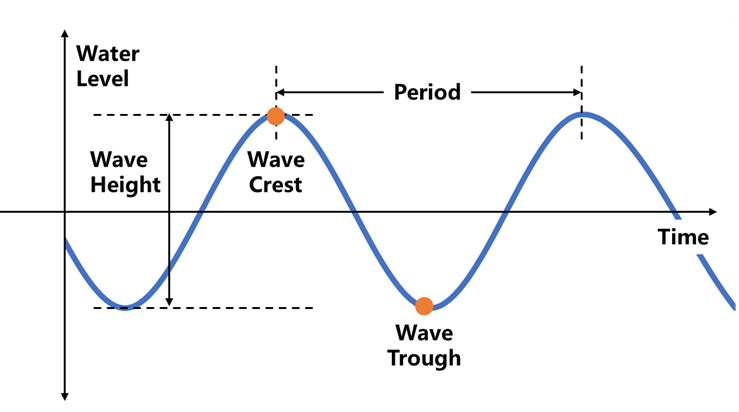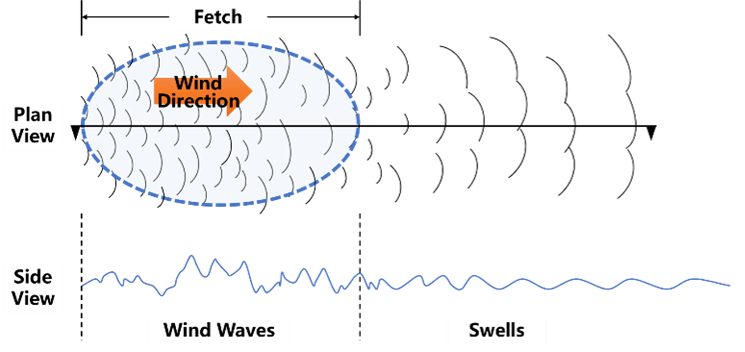Understanding Ocean Waves: Properties, Formation and Classification
Understanding Ocean Waves: Properties, Formation and Classification
CHEUNG Kai-chun Johnny
June 2025
When standing by the sea, watching waves crashing against the shore, have you ever wondered how waves are formed? Ocean waves are one of the most common dynamic phenomena in the ocean. They not only shape the coastline, but also affect the climate and ecosystems, and are closely related to our daily life. Whether they are gentle ripples or huge waves, they are all examples of ocean waves. How can we classify them? Understanding the properties of ocean waves not only deepens our understanding of the ocean, but also helps us cope with future challenges arising from the ocean..
Description of Ocean Waves
Ocean waves are a type of periodic disturbances over the sea surface. Before discussing the wave classification, we first need to understand the parameters commonly used to describe ocean waves (Figure 1):
- Wave Height: The vertical distance between the wave crest (highest point) and the wave trough (lowest point). Higher wave heights indicate greater energy. Typhoons can generate huge waves of over 10 meters in deep ocean. Wave amplitude is one half of the wave height.
- Significant wave height: The average height of the highest one third of the waves as derived from a wave record. This is generally the approximate value most commonly reported by observers at sea, i.e. the characteristic wave height, the height normally given in wave forecasts.
- Wavelength: The horizontal distance between two consecutive crests or troughs. In deep ocean, wave propagation speed is mainly affected by its wavelength.
- Wave Steepness: Defined as the ratio of wave height to wavelength, which measures the steepness of a wave. The larger the wave steepness, the higher the likelihood of wave breaking, which is commonly known as "whitecaps". When wave steepness exceeds 1/7, waves will have a high chance to break.
- Wave Period: The time interval between two consecutive crests or troughs passing a fixed point, typically measured in seconds. Wave period is a key parameter in wave classification.
- Significant wave period: The mean period of the highest one third of the waves as derived from a wave record, i.e. the mean value of the periods corresponding to significant wave heights. This is the characteristic wave period normally given in wave forecasts.

Figure 1 Schematic diagram showing wave parameters.
Formation and Classification of Ocean Waves
Ocean waves are mainly generated by winds. When winds blow across the sea surface, small ripples are formed due to friction. If the wind direction remains unchanged and the wind strengthens, these ripples will gradually grow into larger waves, known as "wind waves". Wind waves typically have short wavelengths and periods. The growth of wind waves mainly depends on wind speed, size of wind field (fetch), and the duration of wind blowing. Generally speaking, stronger winds generate higher waves.
When wind waves propagate away from the wind field, or when the wind direction changes or wind weakens, the remaining waves are no longer influenced by the local wind condition. In deep oceans, interactions among waves cause the wavelengths and periods of the remaining waves increase, forming “swells” that can propagate over long distances (Figure 2).

Figure 2 Schematic diagram showing swell formation.
In deep oceans, strong winds associated with tropical cyclones can generate huge wind waves. When these waves propagate away from the wind field of the tropical cyclone, they will transform into swells and their wavelengths increase. Their propagation speed thus becomes faster than the moving speed of the tropical cyclone. Sometimes, even when the weather along the shallow coastal regions remains calm and pleasant, swells may have already reached the coast, creating unexpected huge waves along the shoreline which could drag people out to the sea, causing injuries or casualties.
Apart from the commonly seen “wind waves” and “swells”, waves can also be classified academically based on their periods, generation mechanisms, and the forces exerting on them (Figure 3):

Figure 3 Classification of waves by period [2].
- Capillary Waves: Small waves that mainly generated by winds and influenced by the surface tension of water. These waves have periods of less than 0.1 second and carry minimal energy, typically appearing in the early stage of wind wave formation. Waves with periods between 0.1 and 1 second are influenced by both surface tension and earth’s gravity and named as "ultra-gravity waves". In general, waves with periods less than 1 second are often collectively known as “ripples”.
- Gravity Waves: Mainly generated by winds and affected by earth’s gravity as they propagate. These waves have periods ranging from 1 to 30 seconds. Most of the ocean waves fall into this category, including the commonly seen wind waves and swells.
- Long Waves: Tsunami is a series of long waves caused by a large and sudden displacement of the ocean, usually generated by submarine earthquakes. They have extremely long wavelengths with wave periods ranging from 5 to 60 minutes. They carry a large amount of energy, and can travel thousands of kilometers across the ocean. When they approach shallow coastal areas, they can transform into huge waves. Besides, storm surges caused by tropical cyclones are also a type of long waves.
- Astronomical Tides: Tides are mainly caused by lunar and solar gravitational forces. Astronomical tides have wave periods of about 12-24 hours.
As a natural phenomenon, ocean waves come in various forms, ranging from wind waves to astronomical tides, each with its unique causes and impacts. Understanding the basic parameters, classification and generation mechanisms of ocean waves is not only crucial for marine users, but also helps us better predict and respond to the changes in ocean and coastal environments.
References:
[1] Introduction to Physical Oceanography, Robert H. Stewart, Texas A & M University, 2009.
[2] New Frontiers in Operational Oceanography, GOADE OceanView, CreateSpace Independent Publishing Platform, 2018.
[1] Introduction to Physical Oceanography, Robert H. Stewart, Texas A & M University, 2009.
[2] New Frontiers in Operational Oceanography, GOADE OceanView, CreateSpace Independent Publishing Platform, 2018.